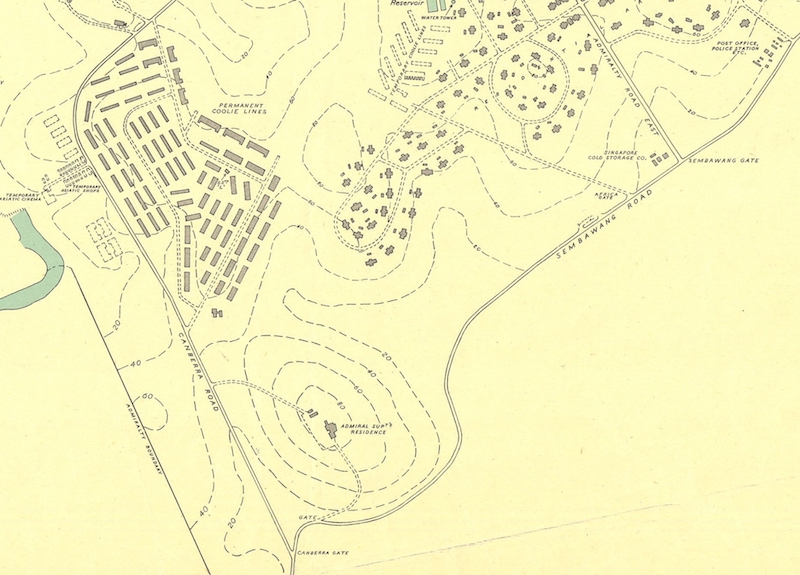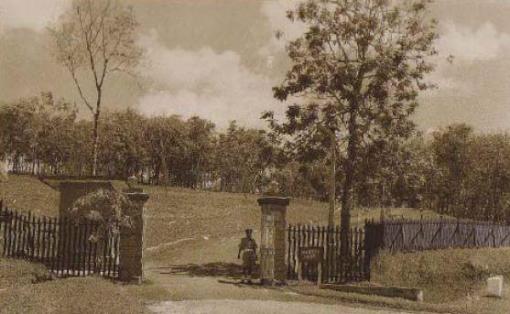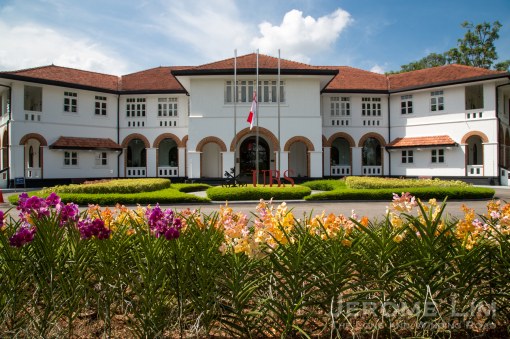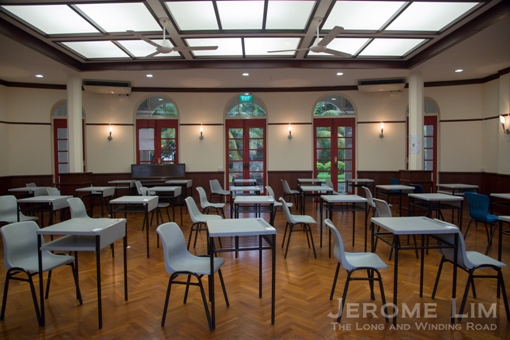From its position some 90 feet above what once was the southern fringes of the His Majesty’s Naval Establishments in Singapore, the grand and architecturally rather interesting building we know today as the Old Admiralty House would have offered its occupants with a wonderful vantage point over the area’s rolling landscape.
Its lofty position, and the scale of the house – likened by some to that of an English manor, tells us of the rank and status of the mansion’s intended occupant, the Royal Navy’s officer in command of the huge naval base. The house, would have been one of a trio of large residences planned for at the end of the 1930s.
The three were to house the each of the three commanding officers of the armed services, with what was to be Admiralty House built so as to permit the Officer in charge of His Majesty’s Naval Establishments in Singapore, a appointment held by the Commodore (later Rear Admiral), Malaya, to be moved on to the grounds of the base. The Commodore’s residence, had been at the then Navy House, located a long drive away in ‘Singapore’ at Woodstock Drive (which became the Grange Road end of today’s Orchard Boulevard).

Rather delightful looking smaller buildings around the house thought to have housed the commanders’ aides.
The two other residences intended, were to be at Kheam Hock Road and in Tanglin. The one at Kheam Hock Road, was to be a replacement for Flagstaff House, the residence of the General Officer Commanding (GOC), Malaya. This residence is the one we know today as Command House, a National Monument. The Tanglin residence, which I have not been able to find further information on, was intended to be the home of the Royal Air Force’s Air Officer Commanding (AOC), Far East.
As with the new Flagstaff House, the design of Admiralty House was very much influenced by the Arts and Crafts movement. It is widely attributed to the illustrious architect, Sir Edwin Lutyens, whose work left a mark not just in Britain, but also in New Delhi. However, there little evidence of this.
Thought to have been completed in 1940, two years after the opening of the massive King George VI graving dock – an event that marked the completion of Great Britain’s most important naval station east of the Suez – the house first occupants would have been Rear Admiral and Mrs. Thomas Bernard Drew, if they had not elected to stay on at Woodstock Drive. Rear Admiral Drew, who was posted to Singapore in February 1939 as a Commodore, Malaya, was promoted to the rank of Rear Admiral in August of the same year.

Detail of a 1945 Map of the Naval Base showing the area where ‘Admiralty House’ is. The house is identified as the ‘Admiral Superintendent’s Residence’ in the map.
It was to be Rear Admiral Drew’s successor as Rear Admiral, Malaya, Ernest John “Jack” Spooner and his wife Megan, who were to be Admiralty House’s first residents, moving into the house in August 1941. Mrs Megan Spooner, née Foster, interestingly had been a renowned soprano back in Britain.

Nelson Gate at the bottom of Nelson Road at the perimeter fence of the Naval Base along Sembawang Road (photograph used with the kind permission of Mr Chan Kai Foo).
We are able to get a feel of how the house was laid out and decorated in Ms. Mary Heathcott’s article published in the 18 October 1941 edition of The Singapore Free Press and Mercantile Advertiser. Here, Ms Heathcott refers to the house as ‘Navy House’, but it quite certainly is a description of the Naval Base’s Admiralty House (Mrs. Megan Spooner also referred to the house as ‘Navy House’ in her diary entries):
Navy House has been built for about a year, was never occupied by the Drews as they were settled in Singapore.
It is large, pillared, cream coloured and grand and when Mrs. Spooner has finished her interior decoration should be a very elegant home indeed for Malaya’s Rear Admiral.
The dining room is furnished already, with solid walnut-polished teak furniture, sober jade green leather chairs. It has an immensely long dining table for big dinners, a small round one for less formal affairs.
A long, many windowed drawing room leads off the dining room, and this Mrs Spooner plans in Empire style, with the delicate graceful studied furniture of the period, mirrors on the walls, console tables, pastel colourings. Off this is a smaller sitting room, informal and restful.
Three hundred and fifty people were recently entertained at a cocktail party in the dining and drawing room of the house and there was no crush at all, which gives you some idea of their pleasant spaciousness.
Upstairs are the private quarters of the Spooners, a big landing sitting room where Mrs. Spooner has her desk, with its photographs of their nine-year old son, now at school in England. Here too, will be a corner settee to offset the rather difficult angles.
For most rooms of the house, there is a pleasant green vista, and from one side can be seen the Straits of Johore through a cutting in the trees.
The garden is as yet a plain green lawn, but there are plans for that too.
That it was referred to as ‘Navy House’, points to the fact that the house probably did not have an official name at its completion. There are also several references to it as ‘Admiral House’ and ‘Admiralty House’ from accounts of its early years.
Geoffrey Till, in his book “Understanding Victory: Naval Operations from Trafalgar to the Falklands”, makes mention of the stay of Rear Admiral Tom Phillips, Commander-in-Chief of the hastily put together Eastern Fleet, in late 1941, at “the new, rambling, vaguely “Arts and Crafts” Admiralty House in Sembawang, Singapore”, identifying Phillips’ hostess as Mrs. Megan Spooner (Admiral Phillips stay at ‘Navy House’ is also mentioned in Mrs. Spooner’s diary).
We also find in another book, “Course for Disaster: From Scapa Flow to the River Kwai”, the recollections of its author, Richard Pool, of his meetings with Mrs. Spooner as a naval officer. One of these encounters was at “Admiralty House in Singapore” on the occasion of a cocktail party Admiral and Mrs. Spooner had hosted, “the day after (HMS) Repulse arrived at the Naval Base”. Pool was a naval officer serving on the ill fated HMS Repulse, and was to survive its sinking not long after that meeting.
Both the accounts are related to the events of December 1941, the month in which hostilities between the Britain and Japan rapidly escalated. Little did Admiral Spooner or his guest at Admiralty House, Admiral Phillips, know of it then, but fate was soon to deal each with a cruel blow. Phillips fate was sealed on board his flagship HMS Prince of Wales in the days that followed. Both the flagship, which Phillips went down with, and the HMS Repulse were sunk off Kuantan in the days that followed Britain’s declaration of war with Japan.

Admiral Sir Tom Phillips (hands on hips) watches his flagship HMS PRINCE OF WALES berth at Singapore on 4 Dec 1941 (source: Imperial War Museums ©IWM (A6787)).
Admiral Spooner, whose last days in Singapore was spent organising the evacuation of civilians, attempted an escape in a motor launch two days before Singaore was to fall. The launch was tracked and attached by the Japanese and having run aground on the island of Cebia (or Tjeba) near Pulau Bangka off Sumatra, Spooner was to spend his last days there, dying in April 1942. He was survived by Mrs. Spooner, who was evacuated on 10 February, and an eight year old son James, who had been left behind in Britain to attend school.
It was only after the war, that the house was to provide the calm its seclusion was meant to give. There are suggestions that it was used as a residence of the Commodore Superintendent of the Dockyard, although I do have my doubts. What is known is that it became the residence of the Flag Officer, Malayan Area as ‘Nelson House’ from September 1948. The transfer of the British Far East Fleet Headquarters to Singapore required the Flag Officer to vacate the residence at 51 Grange Road so that it could then be used to house the Commander-in-Chief (C in C), Far East Station, as ‘Admiralty House’.
This arrangement was to last until March 1958, when a reorganisation of British forces in the Far East meant that the Flag Officer’s appointment was assumed under the responsibility of the C in C. With this, ‘Nelson House’ became the official residence of the C in C and was renamed ‘Admiralty House’. The old ‘Admiralty House’ at Grange Road was later to be demolished, making way at the end of the 1960s for Raffles Institution’s new campus. It was in the days of ‘Admiralty House’, at least in the 1960s, that open houses were to be held annually. This allowed servicemen to visit the grounds for a swim in the pool and maybe have a picnic in the garden.

Old Admiralty House in Grange Road, which was demolished to make way for Raffles Institution at the end of the 1960s (online catalogue of the National Archives).

A member of the Naval Base Police receiving an award at Admiralty House (photograph used with the kind permission of Alfa Andy).
The pullout of British forces in 1971 and the closure of the naval base saw Admiralty House become the residence of the Commander of the ANZUK Force. It was during this time, in 1972, that Queen Elizabeth II and the Duke of Edinburgh had lunch at the house, as part of a visit to ANZUK forces in Singapore. Admiralty House, also known as ANZUK House, as the official residence of the ANZUK forces commander, was to accommodate only two commanders. The force was disbanded in 1975 following decisions by first the Australian, and then British governments’ to pull out of the arrangements. The last to leave was Air Vice-Marshal Richard Wakeford in early 1975, following which the keys to the house was passed to the Singapore government.
Much has happened since the house saw its last military officer. Newspaper reports in May 1976 point to it being rented by an undisclosed local company for S$4750 per month. It was turned into a restaurant and guest house that opened in 1978, which apparently was rather popular with an occupancy rate of 90%. In 1988, plans were announced to turn the building and its grounds into a country club with a caravan park. The application was not approved, and it was relaunched in mid 1989 as the Admiralty Country House. The house and its grounds did eventually play host to a country club as Yishun Country Club in 1991, and then from 2001 to 2006, as the Karimun Admiralty Country Club. It was during this time that the building was gazetted as a National Monument in 2002.
Over the years, and changes in use, the grounds of the building has seen several changes. One change is to Old Nelson Road, the roadway leading up to the house. That used to be Nelson Road (it was renamed in the 1970s, possibly to avoid confusing it with the Nelson Road in the Kampong Bahru area – since expunged), and a through road. The south end of the road was at Nelson Gate, which opened up to Sembawang Road. The road was truncated in the late 1970s when Sembawang Road was widened and the gate removed. There would also have been a helipad in the grounds at the building’s north, probably added in the 1950s.

Evidence of the through road seen in an old lamp post. The post is one of three that can be found on the premises.
The grounds today also see more recently introduced structures such as an entrance gate, a pond, buildings around the swimming pools. Accommodation and classroom blocks were also added by the Furen International School (FIS), which since 2012 has run a boarding school for international students on the premises. As part of the arrangement for the lease of the building, FIS was required to repair and restore the building, which they have done so rather beautifully. This required a huge investment (in the order of a seven digit number) and replacement of fittings true to the original style employed in the building, where these had been previously removed.
Speaking of the swimming pools, one – the deeper pool, is said to have been built by 200 Japanese Prisoners of War (POWs) in 1945. There is another suggestion however, that it was the deepest swimming pool in Singapore and it was built by British POWs in the hope that their captors, who were accommodated in the house, drown during their morning swim!
Another reminder of the war on the grounds is a bomb shelter located across the driveway of the building. This was rediscovered in 1990. The shelter is rather small and was perhaps built to accommodate the main occupants of the buildings. Light fittings can be found in the shelter as well as what remains of a squatting water closet.
Beautifully restored, the building, and its adjoining and auxiliary buildings are now ones we can and should marvel at. Much is in evidence of the Arts and Crafts influence, including the exposed brick seen on the house’s façade at the upper level and the “high-hipped roof” with overhanging eaves that is mentioned in the Preservation of Sites and Monuments write up on the monument. Also in evidence are the generously provided windows and ventilation openings – all designed to maximise comfort in the tropical heat and humidity.
What is particularly interesting is how some of the service rooms are attached to the main building – these typically were detached. It appears that these were where the kitchens and other service rooms were from which access was provided via the back of the main house into the dining room and to the bedrooms upstairs through a narrow staircase. Also around the main house are smaller single storey detached buildings, thought to have accommodated the aides to the commanders.
The house today remains as a reminder of what once was. Much of the area around it has seen a transformation. The vantage point it offers is no longer ones of green rolling hills but of the structures of a growing population on an island state that has benefited greatly from the huge naval establishment the occupants of the house presided over.

The view it now commands is not one of a rolling landscape but of a strange new world that has replaced the naval base its occupant once presided over.
While the building itself is protected as a monument, what surrounds it is not. What the Urban Redevelopment Authority’s 2014 Master Plan reveals is that the hill Admiralty House is perched on, or at least a large part of it, will be given to much needed sports and recreation facilities in an area where the pace of public residential developments is very quickly picking up. It may not be long before much of the green around it – the setting Admiralty House was meant to be given, is lost to grey. We do however, still have that opportunity to celebrate the house and the setting it is in, before that, like in the case of many others before it, is lost to us forever.










































































































Superb article. Very interesting.
Thanks Tim.
My mother was born just before the first bombs landed on Singapore. My father was part of the 1957-1958 renewal of troops. I was born in Singapore in1958. After reading about HRH Queen Elizabeth’s visit to your HDB flat in 1972 and then lunch with HRH Duke of Edinburgh at the Admiralty House, I find your posts to be extraordinarily fascinating.
Thank you.